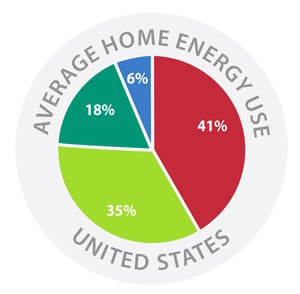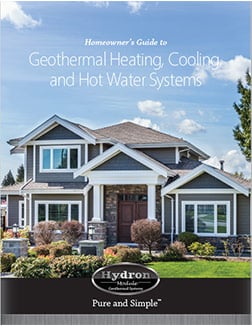A heating and cooling system is one of the most crucial purchasing decisions building owners must make when building or renovating their home, office, or other space. Not only is it a big decision with seemingly limitless options, but it also represents a large share of a typical U.S. household's energy usage. As shown below, 41% of the energy used is in heating, and 6% for cooling. That's almost 50% of the total energy usage! In the average office building, this share is even higher, with heating, cooling, and lighting representing 54%-71% of the overall energy usage.


Instead of fiddling with the thermostat or lighting candles all around the house, there is a far more effective way to reduce your energy usage. Geothermal heat pumps are the most energy-efficient, quiet, and environmentally friendly way to heat and cool any building. The technology utilizes latent solar energy that is stored just underground. This resource is renewable as long as the earth orbits the sun, and keeps the temperature at a very manageable 55° average all year round. This source of energy means that a geothermal system has to work less to produce more, and can fit any application you throw at it with aplomb. It can even connect to a smart thermostat for optimal control no matter where you are.
Geothermal heat pumps reduce energy consumption – and corresponding emissions –up to 44 percent when compared to air-source heat pumps, and up to 72 percent when compared to standard electric.
U.S. Environmental Protection Agency
Ground-source heat pumps (GSHPs) heat and cool structures in a variety of ways. Most people are used to the traditional forced-air heating and cooling methods, at which geothermal excels. However, one geothermal unit can tackle a multitude of applications, such as radiant floor heating, radiant cooling, and handling 100% of your domestic hot water load. A ground source heat pump canheat your pool, your home's floors, and even your driveway and patio! Real-life examples of creative applications from excited homeowners can be found all over the place!
The benefits of heating, cooling, and providing hot water to your home using a ground source heat pump are clear, but, how does it work?
How Geothermal Heat Pumps Work
The heart of the geothermal application is the loop system, which is a series of pipes buried in the ground. As we said before, the geothermal system uses latent solar energy that the earth absorbs, and the loop system is the method by which it extracts that heat energy. The underground pipes contain a water solution and, during the winter, the water in these pipes is warmed by the surrounding soil and transported to your indoor unit. There, heat energy is condensed and warms the home's air or the water in your floors, if you have a radiant application.

Now, in the summer, this process is reversed! The indoor unit draws heat away from the home and into the water solution in the loop system, which dumps the excess heat into the surrounding earth. Two things to note:
1. The geothermal unit handles heating and cooling, all in one, and all indoors. The pump can be kept indoors because it is extraordinarily quiet, especially when compared to a traditional AC unit. This indoor lifestyle that the geothermal system has extends its average lifetime by 92% when compared to conventional HVAC solutions. We're talking 20 to 25 years, on average, of quality performance from a geothermal unit - often longer than that. The ground loops that accompany the unit can last for 100 years or more!
2. The reason that geothermal systems are so efficient is that they, by nature, have to do less work to perform the same task as a traditional system. Where your standard central AC unit must dump the hot air from your home into the blistering heat outside in the summer, a geothermal unit deposits the heat energy into the much cooler soil. The cool soil can take on a lot more heat energy than the hot, humid summer air that surrounds your home.
If you're looking to reduce your energy usage, achieve net-zero, or are just looking to simplify your home, a geothermal heat pump is the best choice for you.
Want to see what type of unit would ideally suit your needs?



